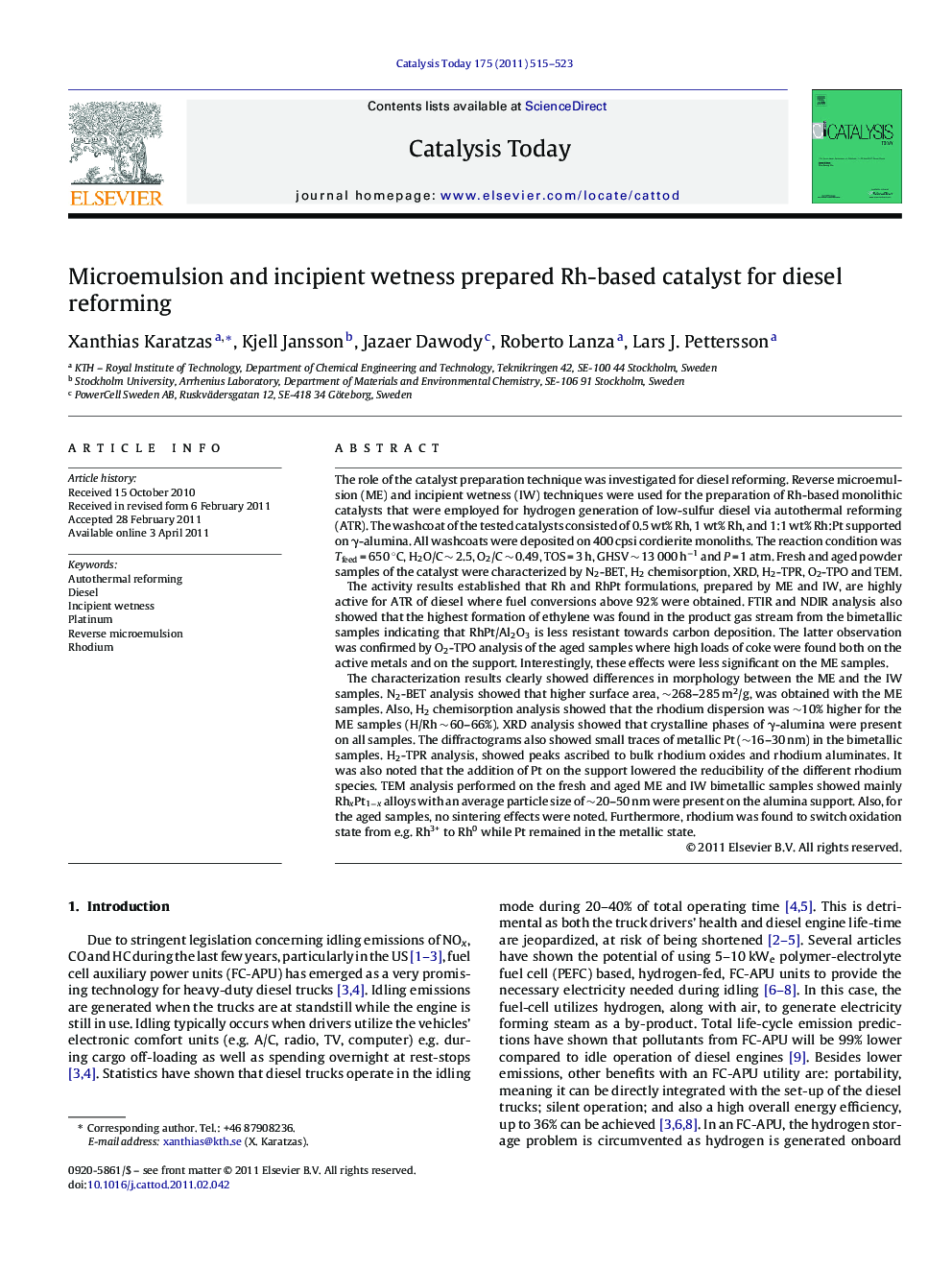| کد مقاله | کد نشریه | سال انتشار | مقاله انگلیسی | نسخه تمام متن |
|---|---|---|---|---|
| 55784 | 47063 | 2011 | 9 صفحه PDF | دانلود رایگان |

The role of the catalyst preparation technique was investigated for diesel reforming. Reverse microemulsion (ME) and incipient wetness (IW) techniques were used for the preparation of Rh-based monolithic catalysts that were employed for hydrogen generation of low-sulfur diesel via autothermal reforming (ATR). The washcoat of the tested catalysts consisted of 0.5 wt% Rh, 1 wt% Rh, and 1:1 wt% Rh:Pt supported on γ-alumina. All washcoats were deposited on 400 cpsi cordierite monoliths. The reaction condition was Tfeed = 650 °C, H2O/C ∼ 2.5, O2/C ∼ 0.49, TOS = 3 h, GHSV ∼ 13 000 h−1 and P = 1 atm. Fresh and aged powder samples of the catalyst were characterized by N2-BET, H2 chemisorption, XRD, H2-TPR, O2-TPO and TEM.The activity results established that Rh and RhPt formulations, prepared by ME and IW, are highly active for ATR of diesel where fuel conversions above 92% were obtained. FTIR and NDIR analysis also showed that the highest formation of ethylene was found in the product gas stream from the bimetallic samples indicating that RhPt/Al2O3 is less resistant towards carbon deposition. The latter observation was confirmed by O2-TPO analysis of the aged samples where high loads of coke were found both on the active metals and on the support. Interestingly, these effects were less significant on the ME samples.The characterization results clearly showed differences in morphology between the ME and the IW samples. N2-BET analysis showed that higher surface area, ∼268–285 m2/g, was obtained with the ME samples. Also, H2 chemisorption analysis showed that the rhodium dispersion was ∼10% higher for the ME samples (H/Rh ∼ 60–66%). XRD analysis showed that crystalline phases of γ-alumina were present on all samples. The diffractograms also showed small traces of metallic Pt (∼16–30 nm) in the bimetallic samples. H2-TPR analysis, showed peaks ascribed to bulk rhodium oxides and rhodium aluminates. It was also noted that the addition of Pt on the support lowered the reducibility of the different rhodium species. TEM analysis performed on the fresh and aged ME and IW bimetallic samples showed mainly RhxPt1−x alloys with an average particle size of ∼20–50 nm were present on the alumina support. Also, for the aged samples, no sintering effects were noted. Furthermore, rhodium was found to switch oxidation state from e.g. Rh3+ to Rh0 while Pt remained in the metallic state.
Figure optionsDownload high-quality image (144 K)Download as PowerPoint slideHighlights
► ATR of low-sulfur diesel.
► Incipient wetness (IW) and microemulsion (ME) prepared catalysts; Rh and Rh-Pt supported on γ-alumina.
► Rh, RhiOx, Rh-Pt and Pt species present on IW and ME samples.
► Highly active; diesel conversions above 92% measured for both IW and ME samples.
► Less coke deposits present on aged ME samples; confirmed by O2-TPO analysis.
Journal: Catalysis Today - Volume 175, Issue 1, 25 October 2011, Pages 515–523